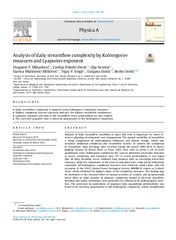Prikaz osnovnih podataka o dokumentu
Analysis of daily streamflow complexity by Kolmogorov measures and Lyapunov exponent
| dc.creator | Mihailović, Dragutin T. | |
| dc.creator | Nikolić-Đorić, Emilija | |
| dc.creator | Arsenić, Ilija | |
| dc.creator | Malinović-Milićević, Slavica | |
| dc.creator | Singh, Vijay P. | |
| dc.creator | Stošić, Tatijana | |
| dc.creator | Stošić, Borko | |
| dc.date.accessioned | 2022-10-04T08:56:43Z | |
| dc.date.available | 2022-10-04T08:56:43Z | |
| dc.date.issued | 2019 | |
| dc.identifier.issn | 0378-4371 (Print); 1873-2119 (Online) | |
| dc.identifier.uri | https://dais.sanu.ac.rs/123456789/13303 | |
| dc.description.abstract | Analysis of daily streamflow variability in space and time is important for water resources planning, development, and management. The natural variability of streamflow is being complicated by anthropogenic influences and climate change, which may introduce additional complexity into streamflow records. To address the complexity in streamflow, daily discharge data recorded during the period 1989–2016 at twelve gauging stations on Brazos River in Texas (USA) were used to derive a set of novel quantitative tools: Kolmogorov complexity (KC) and its derivative-associated measures to assess complexity, and Lyapunov time (LT) to assess predictability. It was found that all daily discharge series exhibited long memory with an increasing down-flow tendency, while the randomness of the series at individual sites could not be definitively concluded. All Kolmogorov complexity measures had relatively small values with the exception of the USGS (United States Geological Survey) 08088610 station at Graford, Texas, which exhibited the highest values of the complexity measures. This finding may be attributed to the elevated effect of human activities at Graford, and proportionally lesser effect at other stations. In addition, complexity tended to decrease downflow, meaning that larger catchments were generally less influenced by anthropogenic activities. The correction on randomness of Lyapunov time (quantifying predictability) was found to be inversely proportional to the Kolmogorov complexity, which strengthened our conclusion regarding the effect of anthropogenic activities, considering that KC and LT were distinct measures, based on rather different techniques. | sr |
| dc.language.iso | en | sr |
| dc.publisher | The Netherlands : Elsevier B.V. | sr |
| dc.relation | info:eu-repo/grantAgreement/MESTD/Integrated and Interdisciplinary Research (IIR or III)/43007/RS// | |
| dc.rights | openAccess | sr |
| dc.rights.uri | https://creativecommons.org/licenses/by-nc-nd/4.0/ | |
| dc.source | Physica A: Statistical Mechanics and its Applications | sr |
| dc.subject | Streamflow time series | sr |
| dc.subject | Kolmogorov complexity based measures | sr |
| dc.subject | Lyapunov exponent | sr |
| dc.subject | Lyapunov time | sr |
| dc.subject | Kolmogorov time | sr |
| dc.subject | Predictability of streamflow time series | sr |
| dc.title | Analysis of daily streamflow complexity by Kolmogorov measures and Lyapunov exponent | sr |
| dc.type | article | sr |
| dc.rights.license | BY-NC-ND | sr |
| dc.citation.spage | 290 | |
| dc.citation.epage | 303 | |
| dc.citation.volume | 525 | |
| dc.identifier.wos | 000474503900026 | |
| dc.identifier.doi | 10.1016/j.physa.2019.03.041 | |
| dc.identifier.scopus | 2-s2.0-85063746210 | |
| dc.type.version | publishedVersion | sr |
| dc.identifier.fulltext | http://dais.sanu.ac.rs/bitstream/id/53100/M22_2019_PhysicaA.pdf | |
| dc.identifier.rcub | https://hdl.handle.net/21.15107/rcub_dais_13303 |

